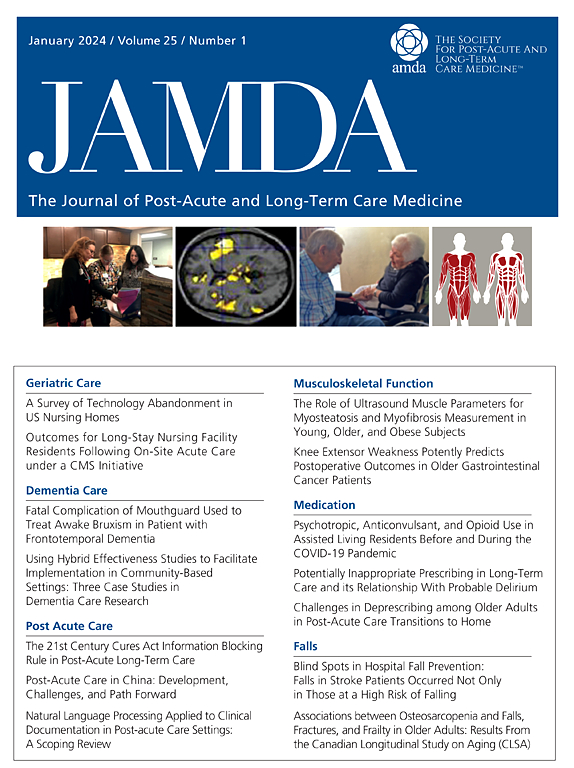种族和民族构成与养老院工作人员水平的关系:2013-2019。
IF 4.2
2区 医学
Q2 GERIATRICS & GERONTOLOGY
Journal of the American Medical Directors Association
Pub Date : 2025-03-14
DOI:10.1016/j.jamda.2025.105496
引用次数: 0
摘要
养老院(NH)的人口已经变得越来越多样化,但许多设施仍然是事实上的种族隔离。本研究探讨了黑人、原住民和有色人种(BIPOC)居民的高比例是否与护理人员水平有关。设计:我们通过链接认证和调查提供者增强报告、LTCFocUS.org、医疗保险成本报告和基于工资的期刊数据,构建了NHs(2013-2019)的纵向队列。进行了独立的多变量随机效应线性回归。背景和参与者:14075个美国医疗保险和医疗补助认证的国民健康保险制度。方法:将BIPOC居民的比例分为各州每年服务最高少数民族居民的10%(高BIPOC)和其余90%(低BIPOC)。护理人员的总水平(HPRD)包括支付小时数(2013-2019年)和工作小时数(2017-2019年)。工作人员包括注册护士、执业护士和执业护士助理。结果:高bipoc和低bipoc NHs之间总员工水平的未调整差异从2013年的-0.23 HPRD (4.19 vs 4.42)增加到2019年的-0.35 HPRD (3.94 vs 4.29)。工作时间的差异从2017年的-0.19(3.55比3.74)增加到2019年的-0.23(3.50比3.73)。在控制协变量后,差异变得更小,但仍然显著(报酬小时HPRD为-0.037,工作小时HPRD为-0.038)。对个别工作人员类型的分析发现,在高bipoc疗养院中,注册护士和认证护士助理(但不包括持牌实用护士)的水平较低。将种族和民族构成作为连续变量或从模型中排除付款人组合的研究结果是稳健的。结论和意义:少数民族居民高度集中的NHs报告护理人员水平较低。改善主要为边缘化种族和族裔群体服务的国民保健服务的人员配备仍然是一项政策优先事项。本文章由计算机程序翻译,如有差异,请以英文原文为准。
Association of Racial and Ethnic Composition with Staff Levels in Nursing Homes: 2013-2019
Objectives
The nursing home (NH) population has become increasingly diverse, yet many facilities remain de facto racially segregated. This study examines whether a high proportion of Black, Indigenous, and People of Color (BIPOC) residents is associated with nursing staff levels.
Design
We constructed a longitudinal cohort of NHs (2013-2019) by linking Certification and Survey Provider Enhanced Reports, LTCFocUS.org, Medicare Cost Reports, and Payroll-Based Journal data. Separate multivariable random effects linear regressions were conducted.
Setting and Participants
14,075 Medicare- and Medicaid-certified NHs in the United States.
Methods
The proportion of BIPOC residents was categorized as the 10% of nursing homes serving the highest minority residents in each state each year (High-BIPOC) and the remaining 90% (Low-BIPOC). Total nursing staff levels in hours per resident-day (HPRD) included both hours paid (2013-2019) and hours worked (2017-2019). The total staff included registered nurses, licensed practical nurses, and certified nurse aides.
Results
The unadjusted difference in total staff levels between High-BIPOC and Low-BIPOC NHs increased from −0.23 HPRD (4.19 vs 4.42) in 2013 to −0.35 HPRD (3.94 vs 4.29) in 2019 for hours paid. The difference in hours worked increased from −0.19 (3.55 vs 3.74) in 2017 to −0.23 (3.50 vs 3.73) in 2019. The difference became smaller but remained significant after controlling for covariates (−0.037 HPRD for hours paid, and −0.038 for hours worked). Analyses of individual staff types found lower levels of registered nurses and certified nurse aides (but not licensed practical nurses) among High-BIPOC nursing homes. Findings were robust to treating racial and ethnic composition as a continuous variable or excluding payer mix from the models.
Conclusions and Implications
NHs with high concentrations of minority residents reported lower nursing staff levels. Improving staffing in NHs serving primarily marginalized racial and ethnic groups remains a policy priority.
求助全文
通过发布文献求助,成功后即可免费获取论文全文。
去求助
来源期刊
CiteScore
11.10
自引率
6.60%
发文量
472
审稿时长
44 days
期刊介绍:
JAMDA, the official journal of AMDA - The Society for Post-Acute and Long-Term Care Medicine, is a leading peer-reviewed publication that offers practical information and research geared towards healthcare professionals in the post-acute and long-term care fields. It is also a valuable resource for policy-makers, organizational leaders, educators, and advocates.
The journal provides essential information for various healthcare professionals such as medical directors, attending physicians, nurses, consultant pharmacists, geriatric psychiatrists, nurse practitioners, physician assistants, physical and occupational therapists, social workers, and others involved in providing, overseeing, and promoting quality

 求助内容:
求助内容: 应助结果提醒方式:
应助结果提醒方式:


